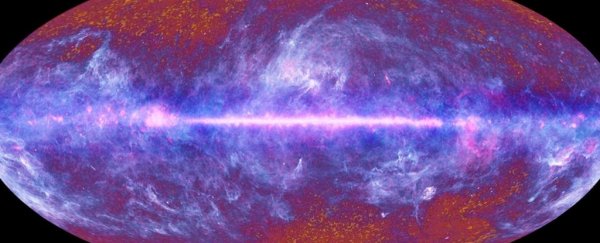When you're inside something, it's hard to see its shape. We're still finding out new things about the shape of our galaxy.
The shape of the Universe? That's a lot harder to gauge, but years of observational data, cosmological models and physics suggest it's flat. Send a beam of photons out across the void, and it will just keep going in a straight line.
A new study argues otherwise. Based on data released last year collected by the European Space Agency's Planck satellite, astronomers have argued the case that the Universe is actually curved and closed, like an inflating sphere.
Which means that beam of photons would eventually come back around to where they started, crossing over other beams that would remain parallel in the flat Universe scenario.
And it would be a big deal. According to an international team of astronomers led by Eleonora Di Valentino of Manchester University in the UK, their findings present a "cosmological crisis" that calls for a "drastic rethinking of the current cosmological concordance model."
The clue to the Universe's curvature, they say, is in the way gravity bends the path of light, an effect predicted by Einstein called gravitational lensing.
Not just any light, either, but the cosmic microwave background (CMB). That's the electromagnetic radiation left over in the space between the stars and the galaxies, dating back to around 380,000 years after the Big Bang when the Universe's first neutral atoms formed.
Once you block out all other sources of light, space glows, really faintly, a sort of background static. It's the oldest light in the Universe.
If you look at data from the Planck satellite, and the 2018 legacy data in particular, it shows that the CMB is being more strongly gravitationally lensed than it should be. The Planck Collaboration called this anomaly Alens, and it's yet to be resolved, but the team believes that one explanation could be the shape of the Universe.
"A closed Universe can provide a physical explanation for this effect, with the Planck cosmic microwave background spectra now preferring a positive curvature at more than the 99 percent confidence level," they wrote.
"Here, we further investigate the evidence for a closed Universe from Planck, showing that positive curvature naturally explains the anomalous lensing amplitude."
A curved Universe may explain this one anomaly, but there are several big problems - not least of which is that all other analyses of Planck datasets, including the 2018 legacy data, have concluded that our cosmological models are correct. That includes the flat Universe.
There are some other problems, too, and the team was careful to note these in their paper. One is the Hubble Constant, the rate at which the Universe is expanding and a thorn in the side of cosmology. No two measurements of the Hubble Constant agree, and curving the Universe just makes predicting it harder.
Data from baryon acoustic oscillation surveys of dark energy - the unknown energy accelerating the expansion of the Universe - are also inconsistent with the closed Universe model, as is cosmic shear data obtained from gravitational lensing observations.
There's another new paper, also, that suggests the Planck Alens discrepancy is some sort of blip in the data (although it's yet to be peer-reviewed).
Astrophysicists George Efstathiou and Steven Gratton of the University of Cambridge also analysed the 2018 Planck data and found evidence for curvature… but when they compared it against other Planck datasets, and baryon acoustic oscillation data, they found "strong evidence to support a spatially flat Universe."
So, broadly speaking, much of the data seems to be in support of a flat Universe, rather than a closed one - except for that one Alens anomaly. Like a pebble in your shoe, or a burr down your shirt, it just keeps on niggling. And we don't know whether the discrepancy between it and all other measurements is actually meaningful, or a problem on the human end.
It is an issue that needs to be resolved, but for the time being, that may not be possible.
"Future measurements are needed to clarify whether the observed discordances are due to undetected systematics, or to new physics or simply are a statistical fluctuation," the researchers wrote in their paper.
We'll be waiting with bated breath.
The research has been published in Nature Astronomy.
